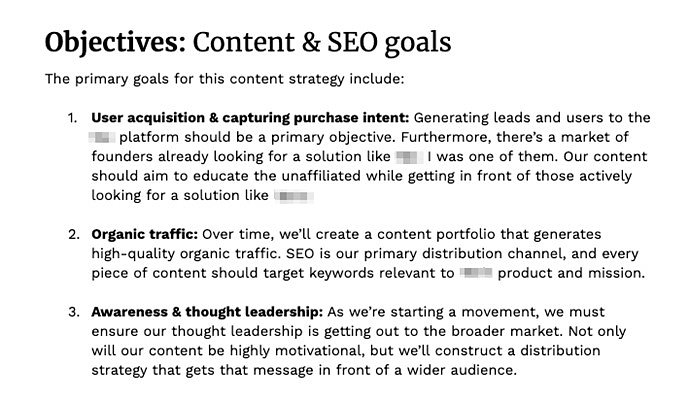How do you know you've created a great piece of content? Pageviews? Social shares? A thumbs up from stakeholders?
Those are all strong indicating metrics; but deep down, we all wish our content generated more leads.
A demand generation-driven approach to content marketing makes that possible—generating leads as well as capturing demand for your products, services, and solutions.
'This article explores a content marketing strategy and philosophy that will help you generate Sales-qualified leads (SQLs) while becoming a leading brand in your space.
The Power of a Demand Generation Content Marketing Strategy: Driving Qualified Conversions
Whether you're increasing paid media performance, boosting sign-up rates, or optimizing the onboarding process, content plays a vital role in every stage of demand generation. And applying a successful demand generation strategy is ultimately how content marketing drives sales.
I view the art of demand generation and content marketing as having two pillars: creation and capture.
Creating demand-generating content builds awareness of a brand, solution, or unknown problem. The goal is to generate interest.
For example, before Basecamp founder Jason Fried launched his email service, Hey, he had been carefully building an audience interested in content about data privacy. Come launch day, Jason had a list of those eager to try the product. He strategically generated demand for an email service focused on data privacy by using content as a communication channel.
Although demand creation can be accelerated, it still takes time. If you're looking to gain SQLs, it's vital to diversify your "content marketing portfolio" with assets that also capture demand.
That usually involves creating content that aligns with the traditional marketing funnel: articles and assets to achieve top-of-the-funnel (TOFU), middle-of-the-funnel (MOFU), and bottom-of-the-funnel (BOFU) objectives.
The goal is to capture a large volume of attention at all stages of the funnel. Product-driven content allows you to capture demand throughout the buying journey.
That isn't as simple as it sounds. Lead generation that casts a wide net can deliver false positives. Only 4.3% of B2B content is for the bottom of the funnel, according to Backlinko.
Content machinery is skewed heavily toward traffic, which doesn't help with short-term sales goals. It's easy to become consumed by subscribers, traffic, and social engagement. Those metrics indicate your content is striking a chord with your audience, but they mustn't shape your content marketing strategy.
Only 12% of sales executives say Marketing-qualified leads (MQL) are essential, according to LinkedIn's The Art of Winning. Content marketing driven by a demand generation strategy shifts the focus away from vanity metrics and more toward real sales opportunities.
If we look at email marketing as an example channel, balancing qualified leads with blog subscribers is crucial. The former fills sales pipeline and leads to revenue (capturing demand), whereas the latter allows you to build an audience for long-term plays (creating demand).
That shift has the added benefit of aligning with sales objectives. Collaboration between marketing and sales teams is vital: Companies with aligned teams increase their business growth.
Now that we've made the distinction between create and capture, let's look at the building blocks of demand generation-driven content marketing strategy.
How a Demand Generation Strategy Applied to Content Marketing Can Attract Sales-Qualified Leads
The first step of demand generation-focused content marketing that drives sales is to put it on paper. Although that may seem self-evident, many organizations fail at that first hurdle. Some 59% of marketers don't document their content strategy, according to a survey by MarketingProfs and Content Marketing Institute.
But documenting content strategy is critical for aligning high-level company goals with content operations and workflows. Attracting SQLs requires a long-term focus, and without a content strategy, you'll often play catch-up on the demands and needs of your customer.
A content strategy also allows you to capture stakeholders' feedback and incorporate their ideas; that can facilitate collaboration with sales and customer success teams to pursue leads that match your ideal customer profile (ICP).
A demand generation-focused content strategy should incorporate the following:
- Objectives. What are you aiming to achieve? How does content fit into the broader marketing and business strategy?
- Organic growth. Although your SEO strategy is a separate entity, you must define how content contributes to organic growth.
- Audience (the Who). 'What are your audience's pain points, and how do they relate to your product? What keeps your audience up at night?
- Materials (the What). How will you help your audience overcome its pain points? Include details on the topics, formats, and themes your content will cover.
- Distribution (the Where). How will you drive qualified traffic and get your content in front of your audience? What channels are your customers most active on, and where can you establish “market omnipresence?”
- KPIs. How will you track progress? What metrics will you measure? Be crystal clear on how you'll measure the success of your content and demand-based marketing efforts.
- Workflows. Outline your content operations process, including stakeholders at each stage of the planning, brief, production, and promotion processes.
Here's an objectives summary from an anonymized content strategy created for one of our clients:

Now that the content strategy is defined, let's look at how we'll apply it to common content formats.
1. Become part of the strategic conversation with SEO-driven content
SEO-driven content is often associated with high-volume TOFU keywords. But it's equally vital for lead generation pieces. In this instance, the key is to focus on...
- Targeting long-tail keywords relevant to your product or solution
- Speaking to the strategic priorities of entire buying committees in your TOFU content
True, long-tail keywords usually have far less search traffic than shorter keywords. However, what they lack in traffic they make up for in search intent. As a result of that intent, you attract leads actively looking to alleviate a problem your products or services solve.
For example, say you want to generate leads for a project management tool. The term "project management" has over 400K search results in a month, but it's nearly impossible to identify search intent at that scale. Are people looking to buy project management software or simply learn what it is?
On the other hand, "project management software" has 60K results. Although it's still wildly competitive, the keyword is more apparent in its intent: Searchers are likely looking for project management software.
As you narrow search intent, search results volume naturally decreases. You can go deeper by focusing and targeting search demand around specific categories of project management software (free vs. paid, for agencies vs. enterprise teams, etc.).
A more focused long-tail keyword such as "free project management software" has approximately 4,500 search results—much fewer than "project management software." However, the search intent is clear, making it ripe for high-quality conversions.
Moreover, long-tail keywords often have less competition. Relevant BOFU content helps build your topical authority, increasing your likelihood of ranking well for relevant keywords in the future.
Homing in on long-tail keywords is a perfect example of using a content strategy focused on demand generation to play the long game rather than chasing short-term results.
2. Use email marketing to solidify your brand
Email marketing drives an ROI higher than any other channel: $36 for every dollar spent, according to a report by Litmus.
Emails must deliver relevant, specific value to recipients. If a large percentage of your audience unsubscribes, or marks your email as spam, it can hurt your domain reputation and increase the risk of your email's going directly into spam.
Furthermore, strict regulations, such as GDPR in Europe, can penalize you for sending marketing emails without explicit user consent.
Done right, email marketing can help you solidify your brand and drive conversions. Overly promotional emails move the needle less than newsletters that offer real value to subscribers.
For example, Peep Laja sends a newsletter out to CXL subscribers every week with new content 'the company has published.

That helps CXL achieve two things:
- Deliver on the expectation of sharing original, high-quality content
- Establish CXL as a trusted media brand
Use engagement metrics (open rates, clickthrough rates, and unsubscribes) to see whether your emails deliver on audience expectations or cause a nuisance in already cluttered inboxes.
3. Build a community around content and employee personal brands
No matter the format, branded content is often taken with a grain of salt. Businesses are inherently self-promotional, regardless of how honest their intent may be. That's where internal subject-matter experts, founders, and employees can help bridge the gap between your brand (a foreign entity) and the relatable humans behind it.
But employee advocacy is a massively underrated content distribution strategy. At the time of this writing, only 17% of businesses have implemented a formal program.
Because many senior executives have many followers on professional platforms such as LinkedIn, the potential reach of their networks can be worth even more than some of your company's paid channels. You're also helping them develop their personal brand by giving them relevant content to share—a classic win-win scenario.
Repurpose your content to expand its reach. Pick a segment from a blog post, craft a brief social post around it, and empower executives and individual contributors to share it with their networks.
LinkedIn also has a useful feature that allows you to send direct notifications to your colleagues whenever you publish a piece on your company's official account. Every share from an employee has the power to boost that content's reach.
4. Supplement organic growth with paid amplification
Although SEO takes time, amplifying organic content using paid media can get it working for you more quickly.
Let's say you're creating a landing page targeting the keyword "best CRM software." It's a high-volume keyword with lots of competition, so it'll take some time to rank.
To boost reach, you can work with your performance marketing team to create SEM ads targeting "best CRM software" to drive traffic to your landing page right away. That will significantly boost the chances of getting your content in front of the right audience.
Perhaps you've created a blog post that highlights a customer success story. It's not just a case study; it tells a story of how your customer solved a specific problem. Amplify the article through Facebook Ads, LinkedIn Ads, or Twitter Ads to get the message in front of those interested in relevant topics.
Once leads start trickling in, you need a well-thought-out strategy to nurture them through the pipeline. Don't let paid traffic fall off a cliff. Offer the right calls to action on your content to generate leads and build your audience at all stages of the funnel.
Demand Generation and Content Marketing Together Achieve Success
Data will always play a vital role in your content strategy. By frequently looking at conversion and engagement rates, you can adapt to emerging customer needs and capture demand as it arises.
It's essential to maintain close collaboration with your sales team members throughout the process. Their qualitative insights will be as relevant as (if not more relevant than) the quantitative data. They have unique insights into which customer segments are most likely to convert and which topics pique interest.
The road to SQLs is paved with persistence. It's unlikely that you'll hit gold in the first few tries. But every failed attempt tells you what doesn't work, and that in itself is a win.
More Resources on Content Marketing and Demand Generation
Creating Content for Effective Demand Generation | MarketingProfs Course
Content + Data: The Pillars of a Successful Demand Gen Strategy
The 4Es of Video: How to Align Your Marketing Content Strategy With Buyer Expectations




